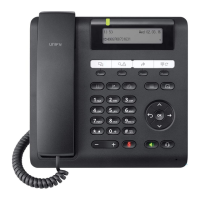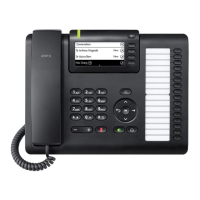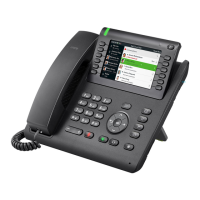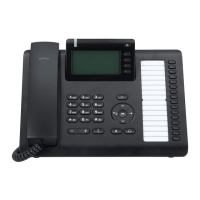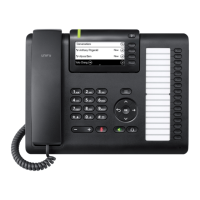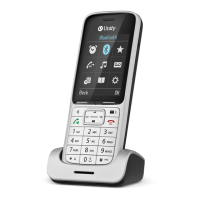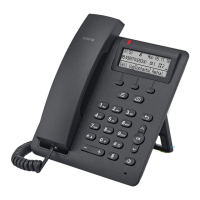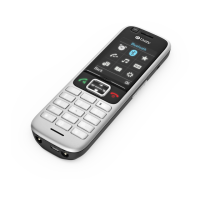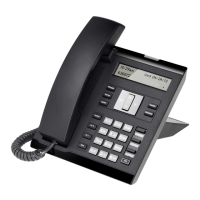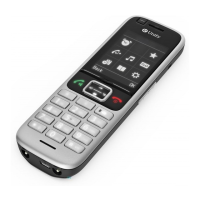Do you have a question about the Unify OpenScape CP200 and is the answer not in the manual?
Information about product trademarks and compliance with EU directives.
Guidelines for cleaning the telephone to prevent damage and ensure proper function.
Information on how to access further documentation and support resources online.
Instructions regarding the phone's software update process and requirements.
Recommendations for optimal placement and environmental conditions for the telephone.
Unify's commitment to environmentally friendly products and ENERGY STAR program.
Details on EULA and Open Source licenses, accessible via the web interface.
How the phone signals and allows answering of incoming calls via handset or speakerphone.
Procedures for initiating calls using off-hook, on-hook dialing, and number entry.
Functions available during an active call like mic control, volume adjustment, and mode switching.
Steps for consulting a second party and establishing conference calls with multiple participants.
Procedures for placing calls on hold and retrieving them, including alternating between parties.
How to manage a second incoming call while already on a call, including acceptance or rejection.
Instructions for transferring calls, including blind and consultative transfer methods.
How to set up, activate, and deactivate call forwarding for different conditions.
Options for enabling visual and audible alerts for call forwarding events.
How to create, edit, and delete contacts in the phone's personal directory.
Information on accessing and searching the corporate directory via LDAP.
How calls are signaled and handled within a call pickup group.
Using DSS keys to call, pick up, or deflect calls for other stations.
Managing multiple lines, including primary, secondary, and phantom lines.
Participating in an active call to provide assistance using Bridged-Call Appearance (BCA).
How to use the mobility function to access your phone settings on another device.
Activating and deactivating the "Do not disturb" (DND) function via the idle menu.
Procedures for changing and managing the user password for security and settings access.
How to activate and deactivate the phone lock feature to prevent unauthorized access.
Optimizing sound settings like room character and ringer.
Configuring ringer files, melodies, and sequences for different call types.
Setting the phone's display language and date/time formats.
Viewing IP address, web interface address, and network activity data.
How to reset user-specific settings to factory defaults.
Comprehensive guide to setting up various call forwarding types and destinations.
How to configure and control call recording modes, including manual and automatic.
Accessing detailed technical configuration and status information of the telephone.
Procedures for importing and exporting contacts using the Web Management interface.
Instructions on how to access the phone's web interface via a browser.
Area for configuring phone and network settings by an administrator.
Navigating the web interface homepage to manage individual menu entries and settings.
Steps for resolving common phone problems like unresponsive keys or no ring.
Steps to access and navigate the phone's local user menu for settings.
Managing outgoing and incoming call settings, including forwarding and CTI.
Overview of functions that can be programmed onto the phone's keys.
Lists functions that are not supported when using the phone with OpenScape 4000.
Information about product trademarks and compliance with EU directives.
Guidelines for cleaning the telephone to prevent damage and ensure proper function.
Information on how to access further documentation and support resources online.
Instructions regarding the phone's software update process and requirements.
Recommendations for optimal placement and environmental conditions for the telephone.
Unify's commitment to environmentally friendly products and ENERGY STAR program.
Details on EULA and Open Source licenses, accessible via the web interface.
How the phone signals and allows answering of incoming calls via handset or speakerphone.
Procedures for initiating calls using off-hook, on-hook dialing, and number entry.
Functions available during an active call like mic control, volume adjustment, and mode switching.
Steps for consulting a second party and establishing conference calls with multiple participants.
Procedures for placing calls on hold and retrieving them, including alternating between parties.
How to manage a second incoming call while already on a call, including acceptance or rejection.
Instructions for transferring calls, including blind and consultative transfer methods.
How to set up, activate, and deactivate call forwarding for different conditions.
Options for enabling visual and audible alerts for call forwarding events.
How to create, edit, and delete contacts in the phone's personal directory.
Information on accessing and searching the corporate directory via LDAP.
How calls are signaled and handled within a call pickup group.
Using DSS keys to call, pick up, or deflect calls for other stations.
Managing multiple lines, including primary, secondary, and phantom lines.
Participating in an active call to provide assistance using Bridged-Call Appearance (BCA).
How to use the mobility function to access your phone settings on another device.
Activating and deactivating the "Do not disturb" (DND) function via the idle menu.
Procedures for changing and managing the user password for security and settings access.
How to activate and deactivate the phone lock feature to prevent unauthorized access.
Optimizing sound settings like room character and ringer.
Configuring ringer files, melodies, and sequences for different call types.
Setting the phone's display language and date/time formats.
Viewing IP address, web interface address, and network activity data.
How to reset user-specific settings to factory defaults.
Comprehensive guide to setting up various call forwarding types and destinations.
How to configure and control call recording modes, including manual and automatic.
Accessing detailed technical configuration and status information of the telephone.
Procedures for importing and exporting contacts using the Web Management interface.
Instructions on how to access the phone's web interface via a browser.
Area for configuring phone and network settings by an administrator.
Navigating the web interface homepage to manage individual menu entries and settings.
Steps for resolving common phone problems like unresponsive keys or no ring.
Steps to access and navigate the phone's local user menu for settings.
Managing outgoing and incoming call settings, including forwarding and CTI.
Overview of functions that can be programmed onto the phone's keys.
Lists functions that are not supported when using the phone with OpenScape 4000.
| Wall Mountable | Yes |
|---|---|
| Type | IP Phone |
| Power Supply Options | PoE or external power adapter |
| Connectivity | 10/100 Base-T Ethernet |
| Power over Ethernet | Yes, IEEE 802.3af |
| Keys | Programmable keys |
| Keypad | 12-key numerical keypad |
| Speakerphone | Yes |
| Headset Port | RJ9 |
| Lines | 2 lines |
| Supported Protocols | SIP |
| Ethernet Ports | 2 |
